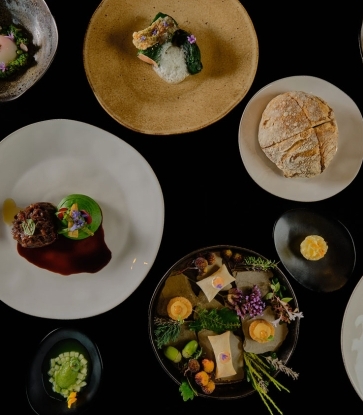Found up and down the East Coast and into the Midwest, the pawpaw feels like it's from closer to the equator. The fruit's flavor is often likened to a cross between a banana and a mango, though others point to notes of pineapple and avocado. It's this unexpectedly tropical taste that makes them beloved by chefs, who utilize them in a variety of sweet and savory preparations.
Possessing a verdant green skin that can take on an almost golden yellow hue, pawpaws are generally shaped like mangoes (some varieties are round or evoke teardrops), weigh anywhere from a quarter pound to a pound and have custard-like pulp dotted with seeds. Their season can start as early as mid-August and run well into October, depending on the weather.
Abundant in the wild, they are cultivated only on a limited basis. Foragers will often harvest those in the backwoods to sell directly to restaurants or at farmers markets. Pawpaws and their pulp are also available online from companies such as Earthy Delights and Regalis.
Since there are 50 or more varieties of the fruit—which can vary widely in terms of flavor and size—some chefs prefer the consistency of farmed pawpaws. Jim Davis operates Deep Run Pawpaw Orchard in Westminster, Maryland, where he has roughly 1,000 trees growing in a six-acre orchard.
It was a tough business to start over 20 years ago. "I had no manual or book to read, because no one else was doing it," he says. "Everyone I spoke to about it thought I was crazy, but I went ahead with it. It has taken years to develop the market, but, finally, there is high interest in the fruit. Every year, the interest ticks up more."
Last year, he reaped just over three tons of fruit. The heavy rains that have been plaguing the region since this summer negatively impacted this year's crop, but Davis is still confident he will sell out of every piece of fruit he does manage to harvest.

Pawpaws can be a difficult fruit to handle. They have a very short shelf life (a week max once harvested) and blemish easily—two reasons why you don't see them for sale at mainstream grocery stores. The other problem is that if the pulp gets seriously bruised, it can negatively impact the flavor. "It's like a virus," says Drew Adams, executive chef of Bourbon Steak in Washington, D.C. "It'll infect the whole batch and ruin it. We found out the hard way. Last year, we had to throw out 40 pounds of pawpaws."
That makes processing the fruit a time consuming and exacting operation. Chef Jeremiah Langhorne at The Dabney, also in Washington, D.C., remembers eating pawpaws as a child while growing up in the District and Virginia, but he didn't start cooking with them until he was working in Charleston, South Carolina at McCrady's with Sean Brock, another native Virginian. That was nearly a decade ago. Now he's used to the pawpaw's temperamental personality.
When he gets them in at the restaurant—sourced from a combination of foragers and growers, though sometimes he still has the opportunity to go out looking for them himself—he immediately processes the ripe fruit (any that aren't fully ready are set aside to finish ripening). Running his knife around its center like he's cutting an avocado, he twists the fruit open and scoops out the pulp with a sharp-edged spoon. Then he passes the custardy innards through a sieve to remove the numerous seeds.
Langhorne will sometimes use pawpaws in dessert preparations, including pudding, ice cream and a riff on banana bread. Other times it will be transformed into jam, mustard for cheese plates and charcuterie boards or swirled into yogurt or sour cream. The pulp can also be frozen, which keeps it fresh for up to a year.
Bourbon Steak's Adams is in the midst of fermenting some of the pulp to potentially make a sauce. "It could taste awful," he says. "But you don't know until you try."
He's working with his pastry chef on another preparation that's a guaranteed home run. In the style of acclaimed French pastry wizard Cédric Grolet at Le Meurice in Paris, they are casting pawpaw shaped shells out of white chocolate, which will then be painted green. The fake fruit will be stuffed with the real thing and placed on a bed of pawpaw ice cream.
Chefs aren't the only ones bewitched by pawpaw—distillers and brewers are starting to fall in love with them as well. B.C. Brewery and Checkerspot Brewing Company, both in Maryland, are producing seasonal beers with the fruit, while Virginia's James River Distillery is infusing rum with it.






















